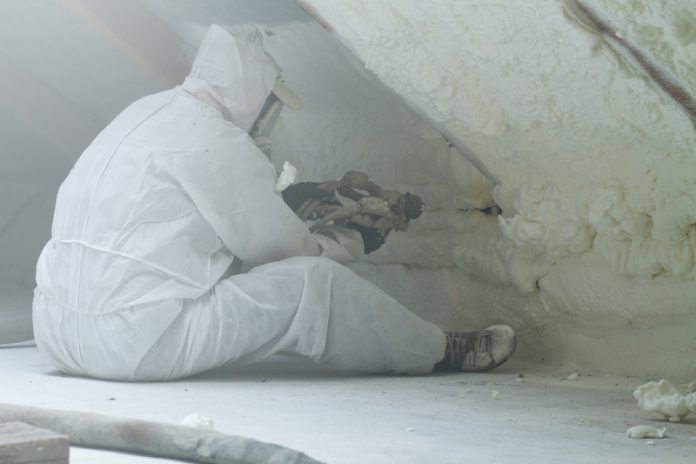Kiwa Building Products Technical Project Manager, Simon Lloyd, looks at the new generation of spray foam insultation products coming on to the market
One of the increasingly popular thermal insulation products in use today is spray foam insulation. While it has been in use for over 30 years, polyurethane (PUR) spray foam insulation products are considered by some to now have the largest market share of insulation products in the non-domestic market, closely followed by domestic retrofit and new housebuilding.
So popular has it become that a new generation of sprayed PUR foam products are coming to market with HFO blowing agents to comply with product standard BS EN 14315-2 In-situ formed sprayed rigid polyurethane (PUR) and polyisocyanurate (PIR) foam products. Specification for the installed insulation products and the Fluorinated Greenhouse Gases Regulations 2015 (or F-Gas Regulation as it is often referred to), which addresses the use of refrigerants and blowing agents.
Ultimately, the goal for the spray foam manufacturers is inclusion in the BRE Green Guide to Specification.
The new products are suitable for use as spray-applied thermal insulation that contributes to other aspects of building physics (eg air-tightness, water-tightness and sound insulation) for roofs, floors and external walls.
There can also be benefits in terms of structural stabilisation and as a repair medium.
Products are primarily for internal applications in existing or new domestic, industrial, commercial, agricultural and renovation projects.
Spray foam insulation can also contribute to solutions for mould, damp, condensation and thermal bridging. The installed products have a relatively high thermal resistance to the insulating layer thickness, saving room space.
Typically, the products consist of two liquid components that are mixed, and applied in-situ with appropriate spray machinery to form an open or closed cell structure of cured rigid seamless foam. The spray foam insulation is applied in layers, until the final required design thickness is achieved. It has excellent adhesion to most surfaces and will naturally expand to fill gaps, corrugated surfaces and complex or irregular structures.
Open cell foam is a soft, flexible, breathable low-density insulation. It is not as good an insulator as closed cell foam, so a thicker layer is needed for the same level of insulation. It is often used as sound insulation as it blocks airflow; however, it allows timber and masonry substrate moisture to dry out by evaporation, so there is less chance of condensation build-up or rot-related problems.
The foam expands to around 100 times its original volume once applied, which allows it to fill hard to reach places that traditional insulation cannot. Open cell spray foam expands and contracts, accommodating a building’s normal movement over time.
Closed cell foam is a hard, rigid medium density insulation and can be used to increase the racking strength of timber frame walls and improve the structural integrity and strength of roofs suffering from nail failure.
Closed cell foam is less permeable to water and has high water vapour resistance, which makes it more beneficial for industrial projects. It provides waterproofing where required and is ideal for use in areas prone to flooding or wind-driven rain.
Closed cell foam products typically have a low thermal conductivity due to the closed cell structure. As the products are an effective moisture barrier, appropriate ventilation is required to prevent the risk of condensation build-up.
The products must be installed by trained and approved contractors with specialist equipment. A pre-installation survey is carried out and the project specific design will include both U-value and condensation risk calculations. The thickness of foam is calculated according to whether the application is required for thermal insulation, structural support or sound-proofing.
There are currently home insulation grants available under the current iteration of the Energy Company Obligation (ECO) scheme, along with various local incentive schemes. Grants are often available for loft, room in roof and solid/external wall insulation.
Please note: this is a commercial profile
Simon Lloyd
Technical Project Manager
Kiwa Building Products
Tel: +44 (0)1332 383333















Great Article! Glad more information on the structual value properties closed cell spray foam can provide on most structures residential and commercial.
I chose open cell spray foam for its soundproofing benefits—and wow!
It made a big difference in our media room and bedrooms.
The foam got into every little gap and sealed tight.
I was also surprised how eco-friendly and non-toxic it is.
Definitely a solid choice for comfort and sustainability.